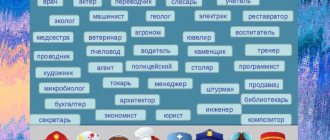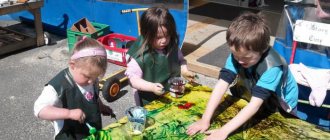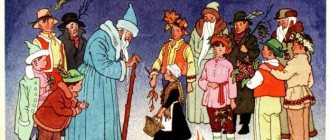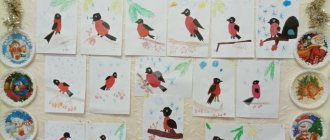Development of spatial orientation skills in preschool children
Development of spatial orientation skills
in preschool children.
Throughout preschool age, spatial orientation skills develop. Productive activity is of great importance in the formation of ideas about spatial relationships between objects and mastering the ability to determine them.
By building with cubes, the child models not only shapes, but also spatial relationships. He learns to convey them in a drawing, arranging images of people and objects in a certain way on a sheet of paper, masters the ability to lay out a certain number of objects in the indicated direction: the top, bottom of the sheet, left, right, middle, etc. Children learn to use words to indicate position objects on a sheet of paper, on a table, on the floor (to the left of, to the right of, above - below, closer - further, near, from behind, along).
Children most successfully master orientation in the surrounding space through didactic games and exercises.
When forming ideas about spatial characteristics, great attention must be paid to activating the speech of preschoolers: they must be constantly involved in independent accurate verbal designation of the characteristics of objects and their parts in shape and size, as well as magnitude relationships during the analysis of samples, planning and accompaniment of activities, in a variety of games and exercises.
For children of the younger group, orientation in space helps them orient themselves in the location of parts of their body (head, legs, eyes, ears, back, etc.) and, in accordance with them, distinguish spatial directions from themselves: in front - behind (behind), above - below, to the right (right) – left (left). Distinguish between right and left hands.
The younger preschooler orients himself on the basis of the so-called sensory frame of reference, i.e. on the sides of your own body. This is what children are taught in everyday life.
This knowledge is refined in didactic games: “Bathing a doll”, “Putting a doll to sleep”, “Dressing a doll”. So the teacher invites the child to wash the doll’s head and face, and then show and name where his face, head, etc. are.
Games using directional arrows help you learn the directions forward, backward, left, and right.
Games with a hanging ball promote the understanding of the concepts of up and down.
To reinforce spatial directions, you can use the game “Where does the bell ring?”
In order not to disorient children, the teacher must remember that in classes where the special task of forming spatial concepts is being solved, the children cannot be placed or seated opposite each other in a circle, since this will disrupt the uniformity of perception of space.
In the middle group, orientation in space develops the ability to determine spatial directions from oneself, to move in a given direction (forward - backward, right - left, up - down); denote in words the position of objects in relation to oneself (there is a table in front of me, a door to my right, a window to my left, toys on the shelves behind me).
Acquaintance with spatial relationships begins: far - close (the house is close, and the tree grows far away).
Here you can use various gaming techniques and games like “Find the hidden toy”, “Where will you go and what will you find”. By completing game tasks, children practice distinguishing and designating the main spatial directions.
To consolidate skills, you can use didactic games such as “Where will we throw the ball?”, “What has changed?”, “Guess what is where,” etc. First, they are given the task of determining the location of one or two toys located in the opposite directions from the child: front-back, right-left. Gradually the number of toys increases to four.
It is advisable to carry out game exercises for the development of orientation in space - finding various objects and toys - not only in a group, but also in the kindergarten area, combining them with the formation in children of such concepts as far - close.
In the older group, the ability to navigate in the surrounding space is improved: left - right, above - below, in front (in front) - behind (behind), between, next to, move in a given direction, changing it according to a signal, as well as in accordance with signs - direction indicators (forward, backward, right, left, etc.).
Orientation in space helps to determine one’s location among surrounding people and objects: “I stand between Masha and Vova, behind Misha, behind Kolya, in front of Nastya, near Vika”; to indicate in speech the relative position of objects: “To the right of the doll sits a hare, and to the left of the doll stands a horse, behind is a bear, and in front is a car.” Orientation on a sheet of paper (right - left, top - bottom, middle, corner).
During the learning process, it is recommended to widely use various didactic games.
Game “Guess who is standing where”, “What has changed?”, “Find something similar”, “Tell me about your pattern”. You can give the task to talk about the pattern that they drew in drawing classes.
Game "Artists". The game is intended to develop orientation in space, to consolidate the terms that define the spatial arrangement of objects, and gives an idea of their relativity. Conducted with a group or subgroup of children. The role of the leader is performed by the teacher.
In the same group, children develop the ability to change direction while moving. Didactic games also help with this.
Game “Find the toy”, “Room around the room”. In the future, the number of tasks to change direction can be increased. For example: “Walk forward five steps, turn left, take two more steps, turn right, walk to the end, step back left one step.”
It is useful to conduct games and mazes, invite children to determine the direction of movement using arrows or move in accordance with the route plan. Such games concentrate attention and help to overcome the path according to a pattern that indicates the beginning and end of the movement. Using the simplest movement patterns, children find the bunny's bast hut in the forest, help Dunno get to the magical land of Mathematics, etc. Children not only follow the directional arrows and describe the path, but also, with the help of the teacher, model their own route plans.
In the preparatory group, orientation in space allows you to navigate on a limited surface (sheet of paper, blackboard, notebook page, book, etc.); place objects and their images in the indicated direction, reflect in speech their spatial location (left, right, above, below, left, right, above, below, in the upper left (lower right) corner, in front, behind, between, next to, etc. .).
Children learn to read the simplest information indicating spatial relationships and the direction of movement of objects (from left to right, from right to left, from bottom to top, from top to bottom); independently move in space, focusing on conventional designations of the direction of movement (signs and symbols).
Strengthen the ability to navigate in space with the help of symbols, plans, routes and diagrams; They are taught to determine the direction of movement of objects and to reflect their relative positions in speech.
The teacher should pay special attention to developing in children the skills of safe behavior on the roadway, related to orientation in space. For this purpose, various games are played, for example: “I am a pedestrian”, “How to avoid traffic”, “Choose the correct answer”.
A special place is occupied by work on the development of orientation on a plane (sheet of paper, page of a book, notebook, etc.).
Along with this, more subtle spatial differentiations are formed in six-year-old children: the ability to find the top and bottom lines, right and left, top and bottom edges of a sheet, upper left (lower left), upper right (lower right) corner; They are taught to carefully place objects in the same direction, observing the same intervals.
It is useful to carry out visual dictations on the location of objects (figures) on a sheet, to practice composing compositions (ornaments) with subsequent verbal designation of spatial relationships. It is also recommended to play games: “Who will remember and tell?”, “What has changed?”, “What are the differences?”, “Paired cards”, “Journey through the labyrinth”, “Describe the path of a fairy-tale hero”, etc.
When developing orientation in space and spatial relationships in preschool children, physical exercises are of great importance.
In general developmental exercises, spatial orientation develops quickly, because here visual and musculocutaneous sensations are simultaneously involved, at the same time the exercises are accompanied by explanations, instructions, and commands from the teacher.
When performing exercises, the teacher uses a variety of objects and aids (gymnastic sticks and benches; hoops, balls, cubes, rings), influencing various receptors and analyzers (visual, auditory, tactile, vestibular, etc.). The manuals create interest in children’s activities and have a significant impact on the development of movements, sensory abilities, and motor qualities.
Active actions with objects during the exercises contribute to the knowledge of color, weight, shape, quality of material and other properties of objects. Action with objects makes it possible to achieve greater clarity of motor ideas, which are based on various sensations and perceptions.
Visual perceptions create an image of movement in its dynamics, expressiveness, and spatial relationships. Objects create, as it were, visual landmarks in the development of spatial orientations and contribute to better coordination of movements of individual parts of the body.
Drill exercises are of great importance in the formation of spatial orientations: various formations and methods of formation. In preschool age, the following formations are used: scattered, in a circle, column, line, etc.; formation changes (from a column one at a time to a column of two, three, four, a line, etc.), turns in different directions (right, left, around), opening and closing, all movements in space (in various formations and scattered) - used when performing various physical exercises (in classes, morning exercises, in outdoor and round dancing games, in festive processions, on walks and excursions).
With various movements and combinations, the familiar space expands. In this regard, during one lesson it is necessary to use a variety of already familiar methods of construction and restructuring and gradually introduce new options and combinations, including by changing the “starting point”, i.e. changes in the direction of movement of the body and its parts relative to itself and various visual landmarks (for example, relative to the sides of the hall)
Outdoor games serve as a method of improving motor skills already mastered by children and developing physical qualities. Such motor activity promotes the ability to navigate a changing environment, find a way out of a current situation, quickly make a decision and carry it out, show courage, dexterity, initiative, and independently choose a way to achieve a goal.
Research by psychologists shows that thanks to play activities, the child practically masters space and objective activity, and at the same time, the very mechanism of perception of space is significantly improved.
In the game, the perception of space appears in its main forms: direct, cognitive-sensory (sensory-figurative) and indirect (logical thinking, concept).
In an outdoor game, two components interact: the rules of the game, formed by the teacher, create the necessary preliminary spatial orientation for the child’s actions, and at the same time, unexpected changes in the game situation (in connection with the actions of the driver or signals) violate the action plan and require a more complex - instantaneous children's reactions and their spatial orientation. This reaction is determined by the child’s level of development of the ability to adapt his actions and movements to the given environment.
The ability to navigate in environmental conditions is facilitated by the deliberate creation of obstacles on the way to completing a game task (the use of objects and aids previously laid out in the game space). For these purposes, it is necessary to use a variety of game options.
The child’s orientation among quickly moving scattered children is very important. It is the most difficult due to the need for an instant reaction to the continuous change in the game situation.
In outdoor play, a child practices a certain proximity or distance of objects, a person, due to which he develops visual assessments, as well as spatial-auditory orientation (far - close, etc.).
Summary of GCD in the senior group. Spatial relationships: left, right
Summary of educational activities in the senior group.
Author: Irina Ivanovna Shishkovskaya, teacher of the senior group of compensatory orientation of the MBDOU “TsRR-d/s “Chaika”, Abakan. Description of the material: this material is intended for children of senior preschool age. It will be interesting and useful for preschool teachers in the field of Cognitive development. The summary was compiled taking into account the Federal State Educational Standard. Topic: Spatial relationships: left, right. Goal: Creating conditions for the formation of spatial relationships: right, left. Objectives: 1.Create conditions for the formation of spatial relationships: left, right and the development of spatial representations. 2. Provide conditions for the development of children’s search activity. 3. Create conditions for children to make their own decisions and show initiative and independence. 4. Create conditions for children to express their thoughts and to encourage children to engage in speech activity. 5. Promote the development of skills for constructive interaction between children and peers. Organization of children's activities: 1. communication between a child and an adult; 2. communication of the child with peers; 3. research activities. Preliminary work: learning finger gymnastics “Clap, palm” and physical education with children; reading N. Nosov’s book “The Adventures of Dunno and His Friends”; acquaintance with the images of “Why” and “Dunno”. Equipment and materials: magnetic board with magnets; pictures: Pochemuchka, Dunno, fork in the road, birch, fox, wolf, bear, hare, deer, squirrel, wild boar, badger, beaver; travel route map; jars with a mixture of dirt and water, bottles with cloudy liquid; chalk; icons for the Pochemuchek and Dunno teams; 2 drawings of city streets; 2 drawings of a five-story building; 2 sets of numbers 1-10; drawings-riddles according to the number of children; colored pencils, wax crayons, felt-tip pens. The course of direct educational activities. Introductory part. Children are included in the group. On the board hangs a poster with a picture of two friends: Pochemuchka and Dunno, who are standing at a fork in the road. The adult does not pay attention to the board. Children discover the poster on their own, gather around the board, and turn to an adult with questions. Educator: - Who do you think is depicted on the poster? -Why are Dunno and Pochemuchka so thoughtful? (Children’s assumptions.) Educator: -Pochemuchka and Dunno were standing at a fork in the road. No one could understand where is right and where is left. But suddenly Dunno scratched his head with the same hand with which he wrote, flipped through the pages and held the map. -How can I get home? - a cry was heard: Where is the right, where is the left - none of them knew. The children carefully examine the poster and notice some kind of paper in Dunno’s hand and express their assumptions. Educator: - Indeed, this is a map. Do you know where is right and where is left? Let's check it out. Game exercise (finger gymnastics) “Clap, palm” Children stand in pairs facing each other. They recite a poem and at the same time perform the movements: Here is our game: Clap, palm, Clap, another. Right palm and then clap louder with your left palm. And then, then, then the left one will beat the right one. Educator: -How can you help your friends? Children's guesses. Children express their own feelings, construct a complete answer, and build a logical chain. Educator: -Friends got lost on their way to visit their animal friends in a forest clearing. To help them meet and return home, and most importantly, not get lost in an unfamiliar area, we will use a map. -We need to make a few stops. -What will we take on the journey so that our friends can get home quickly? -What is the fastest passenger transport? Children's guesses. Planning stages of activity. Educator: - Let's hit the road. Physical education Hands to the sides - take flight We send the plane: Right wing forward, Left wing forward Our plane flew. Main part A painting depicting a clearing with a birch tree in the center. Cards with pictures of animals. 1st stop “In a forest clearing” Educator: -Adult animals, mothers and fathers, went into the forest for food, and left their cubs in the clearing. -Which cubs are left in the clearing? For a fox - (little fox) For a bear - (little bear) For a hare - (little hare) For a deer - (fawn) For a squirrel - (little squirrel) For a beaver - (little beaver) For a wolf - (little wolf) For a wild boar - (little hog) For a badger - (badger) Children name the cubs and, through free choice and the ability to agree, sort out cards with images of animals, on the back of which signs of their location are inscribed. Educator: -When leaving, the parents asked their children to wait for them near the birch tree, which stood in the center of the clearing. -Now, each of you will turn into artists, and together we will create a picture (each team receives pictures with identifying signs on the back) Little fox to the right of the birch, Little bear to the left of the birch, Little boar under the tree, Little squirrel on the tree, Little hare in front tree, Fawn to the right of the little fox, Little Wolf to the left of the bear cub, Little Beaver next to the little hare, Little Badger behind the little fox. Children arrange the animals in the stated order around the birch tree using magnets and a magnetic board. Educator: -We visited friends Pochemuchka and Dunno and flew on. Physical education Hands to the sides - take flight We send the plane: Right wing forward, Left wing forward Our plane flew. Educator: 2nd stop “Swamp” -We landed near the city where our friends live. But it seems we can’t get through here... The children examine the soil, sample the water, and conclude that in front of them is a swamp. On the way to the city there is a swamp, in order to get through it, we all need to go together “trace after trace.” We will go to the right - 1,2,3. And now to the left - 1,2,3. And again to the left - 1,2,3. Again everything to the left - 1,2,3. Children move along a path drawn in chalk. Stop 3 “City” Educator: -The swamp was behind us, and we found ourselves in the city. -But how can you find, among many houses, houses where friends live? - It is known that on the same street as Dunno and Pochemuchka, new houses were built for the numbers, so that they could all live together in harmony, and they would not be bored. Let's find Pochemuchka's neighbors and Dunno's neighbors. An adult suggests dividing into teams. Children suggest ways to divide into 2 teams, those who help Pochemuchka and those who help Dunno. For each team, a 5-story house with two windows on each floor is drawn. Numbers are distributed, on the back of which are the letters L (left) and P (right), and the floor number. It is necessary to “distribute” the numbers among the window apartments. Educator: - From the neighbors, we learned that Pochemuchka lives in the tallest building on the fifth floor, in the apartment on the left, and Dunno lives in the lowest building, on the fourth floor, in the apartment on the right. Help me find their windows. (Drawings of city streets) Educator: -Friends were so happy to return home that they asked their friend Tubik to give you drawings - riddles that need to be completed and turned into pictures from our trip. Each child decides for himself what he will use to draw. To do this, there are colored pencils, wax pencils, and felt-tip pens on the table. The task is performed to the song “If you went on a journey with a friend.” Final part Educator: - Guys, did you like our trip? What good deeds have you done and who have you helped? Did we manage to accomplish what we planned? What helped us with this? Statements and conclusions of children.
We recommend watching:
Math holiday in kindergarten. Senior group Game manual on FEMP for children of the senior preparatory group of kindergarten Synopsis of an elective in the senior group. Entertaining mathematics for preschoolers Summary of GCD in mathematics in the senior group. Journey through a fairy tale
Similar articles:
Notes for mathematics classes in the senior group
Summary of a lesson on FEMP in the senior group of a preschool educational institution. Topic: Orientation in space
Summary of a math lesson in the senior group on the topic: New Year
Summary of a lesson on FEMP in the senior group of a preschool educational institution. Topic: “Composition of a number of units (number 7)”
Planning for FEMP in the senior group according to Pomoraeva




